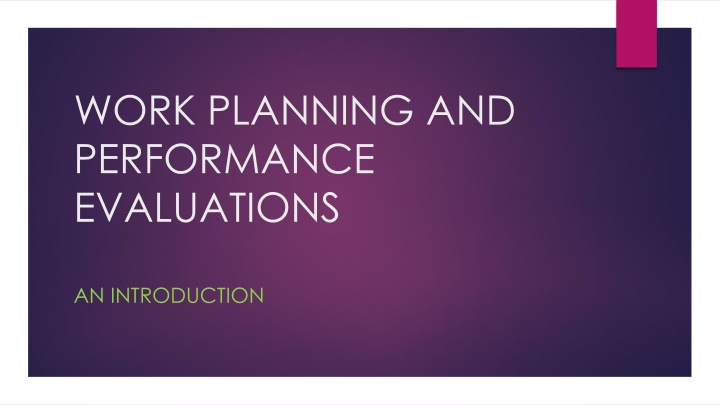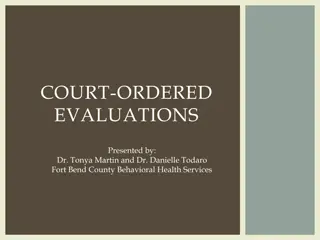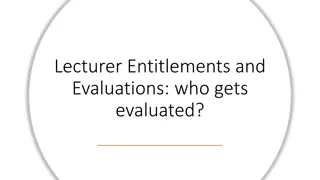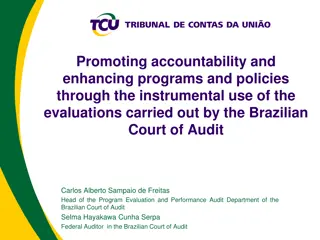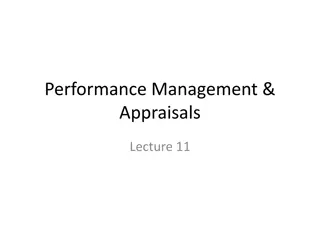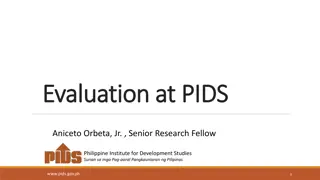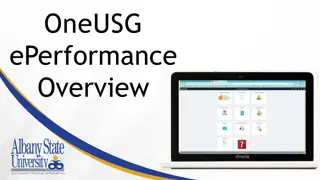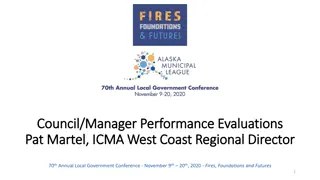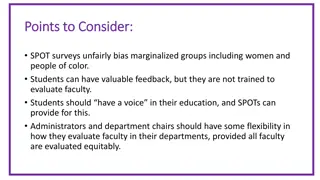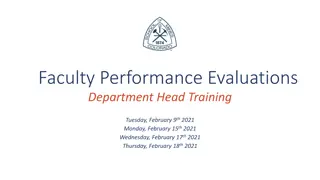Work Planning and Performance Evaluations - An Overview
This introduction covers the importance of work planning and performance evaluations in achieving organizational goals. It outlines the stages of the evaluation process, including work planning, work progress review, formal performance evaluation, and performance evaluation interview. Guidance on using and completing the Work Planning and Performance Evaluation (WPPE) form is provided, along with references to guiding laws, rules, and policies that govern the process. The content emphasizes the significance of setting job tasks, performance standards, and measurements, as well as providing feedback to enhance employee effectiveness and motivation.
Download Presentation

Please find below an Image/Link to download the presentation.
The content on the website is provided AS IS for your information and personal use only. It may not be sold, licensed, or shared on other websites without obtaining consent from the author.If you encounter any issues during the download, it is possible that the publisher has removed the file from their server.
You are allowed to download the files provided on this website for personal or commercial use, subject to the condition that they are used lawfully. All files are the property of their respective owners.
The content on the website is provided AS IS for your information and personal use only. It may not be sold, licensed, or shared on other websites without obtaining consent from the author.
E N D
Presentation Transcript
WORK PLANNING AND PERFORMANCE EVALUATIONS AN INTRODUCTION
GUIDING LAWS, RULES, POLICIES Title 4, Guam Code Annotated Chapter 10, GMHA Interim Personnel Rules and Regulations Government of Guam Competitive Wage Act of 2014 GMHA POLICY NO. 8650-1.204: Probationary and Scheduled Performance Evaluation NOTE: These slides will help you use and complete the Work Planning and Performance Evaluation (WPPE) Form, a.k.a. Long Form. For guidance in completing the probationary period performance evaluations, please refer to the Probationary Period Power-point Slides.
GUIDING LAWS, RULES, POLICIES GMHA Informational Circular 2020-066 Is a reminder to attach a completed (rated or unrated) Work Planning and Performance Evaluation (WPPE) Form along with your employees satisfactorily or above average completed sixth (6th) month probationary period evaluation.
GUIDING LAWS, RULES, POLICIES GMHA Informational Circular 2020-067 REQUIRES every Work Planning and Performance Evaluation (WPPE) form to include the following PROFESSIONAL RESPONSIBILITY Job Factor(s): Quality Assessment and Performance Improvement (QAPI) Safety Learning System (SLS) Health Insurance Portability and Accountability Act (HIPAA) Infection Control (Added) 1. 2. 3. 4.
USING AND COMPLETING THE WPPE FORM THE FOUR (4) STAGES OF WORK PLANNING AND PERFORMANCE EVALUATION (WPPE) STAGES: 1. WORK PLANNING 2. WORK PROGRESS REVIEW 3. FORMAL PERFORMANCE EVALUATION 4. PERFORMANCE EVALUATION INTERVIEW
WORK PLANNING The supervisor meets with the employee to identify job tasks and develop job factors, performance standards, and its measurements. To communicate organizational goals and objectives, and to identify individual accountability for the performance of important job tasks. This always takes place at the beginning of the rating period. For incumbents, this should begin soon after the latest formal evaluation has been conducted. The Work Planning section of the WPPE Form is completed and signed.
WORK PROGRESS REVIEW The supervisor informally meets with the employee to review employee s work progress, and if necessary, update tasks and standards. To improve employee effectiveness by providing adequate feedback and/or constructive criticism so that the employee is motivated to meet or exceed the established performance standards. This stage may take place at any time during the rating period when requested by either the supervisor or the employee. The Work Planning section is referenced, especially if employee is not meeting work expectations.
FORMAL PERFORMANCE EVALUATION The supervisor rates the employee s overall performance against the established performance standards for the rating period. To assign the employee a performance rating which may be used in making personnel decisions (i.e. salary increments, order of layoffs, and suitability for promotion). This stage takes place approximately one month prior to the end of the rating period. The Performance Evaluation section of the WPPE Form is completed and signed.
PERFORMANCE EVALUATION INTERVIEW The supervisor meets with the employee to discuss the employee s final performance rating for the period. To communicate to the employee how well he or she met the objectives of the organization. After the discussion, both you and the employee should sign the appraisal form. Give a copy to the employee; Keep a copy for your file. Both the Work Planning and the Performance Evaluation sections of the WPPE Form are referenced. It is recommended that the Performance Evaluation section be completed prior to meeting the employee. Forward the original to your Department Head, Division Head and the Hospital Administrator/CEO for signature; Forward to the Human Resources Department to be filed in the employees jacket, and then to process the appropriate salary increment.
WORK PLANNING STEPS STAGE 1
KNOW THE JOB AT THE BEGINNING OF THE RATING PERIOD Make a thorough review of what the employee is doing and what you want the employee to be doing based on the job specification. Review your employees up-to date position description and the job specification for that position. Know and understand GMHA s strategic plan and core values. Align the employee s job factors with your departmental goals and objectives as well as the overall goals and objectives (Strategic Plan) of GMHA.
IDENTIFY JOB FACTORS WAYS TO INDENTIFY JOB TASKS/FACTORS Sample Position Description - SECRETARY FIGURE 1 Discuss and agree with your employee on the most frequent and critical duties of the job. A. Major Duties I serve as personal assistant to Executive Assistant to the Regional Director. --- I take dictation or transcribe from machine. I type variety of narrative or other materials. I perform all clerical duties including filing. Use your employee s position description to identify the major, specific, continuing and significant tasks and duties. --- I arrange travel for Executive Assistant; make his appointment, sometimes on own initiative; determine what mail will be referred to him; prepare for his signature letters for which he has necessary information and background. --- I attend meetings of Regional Advisory committee or similar bodies; records proceedings in shorthand, transcribe notes, and prepare minutes. From daily incoming correspondence, I select materials for periodic mailing to committee members. I keep records on members of Regional committee and park commissions, maintaining contact with parks as indicated. I make arrangements for committee meetings. Underline all verbs and objects of the verbs (FIGURE 1). --- I maintain fiscal records for External Affairs, prepare annual budget material, keep time cards. I keep fiscal records on Historic site and on other affiliated areas as indicated. --- I conduct some research and otherwise assist Executive Assistant in preparation of publications for use in state coordinated or advisory body programs.
IDENTIFY JOB FACTORS Your task statement should start with an action verb and has the what , how , and why of the work activity. Sample List of Duties - SECRETARY FIGURE 2 1. 2. 3. 4. 5. 6. 7. 8. 9. 10. 11. 12. 13. 14. 15. 16. 17. 18. Takes dictation from machine and at meetings Transcribe from machine and from notes Types variety of narrative/other material Arranges travel for Executive Assistant Makes appointment for Executive Assistant Determines mail to be referred to Executive Assistant Prepares letters for signature of Executive Assistant Attends meetings of committees Prepares minutes Selects materials for periodic mailing to committee members Maintains committee records Makes arrangements for committee meetings Maintains fiscal records for External Affairs and for Historic Sites Prepares annual budget material Keeps time cards Conducts publications research Assists Executive Assistant in preparing publications Files memos, letters, reports, and other correspondence List the duty statements (FIGURE 2) Avoid minor duties and general statements, such as: type correspondence from rough draft; type various forms; type reports. These tasks are too detailed and involve the same duty of typing
IDENTIFY JOB FACTORS Group the critical list of duties that have common results or like products; then list the major task(s) that fall under the group (FIGURE 3). Sample Grouping of Duties - SECRETARY FIGURE 3 DUTY (GROUPING) DESCRIPTION OF GROUP (JOB FACTOR) 1. 2. 3. 9. Dictation & Typing I 18. 15. 11. 5. 13. 14. 16. 17. Clerical II Fiscal Work III Publications IV 4. 12. Makes Arrangements V 6. 7. 10. Correspondence VI
ESTABLISH PERFORMANCE STANDARDS THE PURPOSE OF HAVING STANDARDS IS TO BE SPECIFIC AND OBJECTIVE IN COMMUNICATING TO THE EMPLOYEE WHAT IS EXPECTED. STANDARDS SHOULD BE Observable, Clear and specific Realistic Free from bias, personal feelings or opinions Contain finite expectations that specify the line between satisfactory and unsatisfactory work Linked to the performance standards of the Hospital Administrator/CEO and the overall mission of GMHA. Setting of standards should be a joint effort between supervisor and employee, because the employees involvement may result in more realistic, thorough standards and assist to develop employee commitment to the standards.
ESTABLISH PERFORMANCE STANDARDS TYPES OF STANDARDS QUANTITY QUALITY measures how many or how much of something is required to meet the level of performance being described. Examples: Evaluates at least 90% of received applications per month. Receives no more than 2 complaints per 20 customers. how well the task is performed; quality is usually expressed by accuracy, appearance, or effectiveness of the work effort. Examples: Adheres to established policies and procedures. Is 100% in compliance with rules and regulations.
ESTABLISH PERFORMANCE STANDARDS TYPES OF STANDARDS TIMELINESS measures completion times which are usually expressed by how quickly, when or by what date work is produced. Examples: Maintains weekly staff schedules. Submits reports at the end of each month. MANNER OF PERFORMANCE refers to behaviors involved with the job, requires knowledge beyond basic qualifications. Examples: Routinely works collaboratively with payroll section. Displays understanding, courtesy, tact and politeness to customers.
ESTABLISH THE MEASUREMENT Connect or tie each performance standard or expectation to some type of tracking or monitoring system which already exists that provide credible and/or reliable information, feedback, or evidence about the employee s work performance or productivity.
MEASUREMENT EXAMPLES: QUALITY CONTROL RECORDS/REPORTS CUSTOMER FEEDBACK CUSTOMER COMPLAINT SUPERVISORY SPOT CHECK SUPERVISORY REVIEW SUPERVISORY OBSERVATION INCIDENT REPORT
STAGE 1 - YOURE DONE THE WORK PLANNING STAGE IS COMPLETED BY SIGNING AND DATING (BOTH EMPLOYEE AND SUPERVISOR) THE ACTION AT THE BOTTOM OF THE WORK PLANNING SECTION OF THE FORM.
WORK PROGRESS REVIEW STEPS STAGE 2
PREPARE A WORK PROGRESS FOLDER USE A MANILA FOLDER OR AN ELECTRONIC FOLDER ON THE COMPUTER TO PLACE NOTES AND OR JOT DOWN EVIDENCE OF WORK PERFORMANCE THAT YOU AS A SUPERVISOR KNOW TO BE IMPORTANT IN MEETING WORK STANDARDS OR EXPECTATIONS. MAKE A HABIT TO DISCUSS WORK PERFORMANCE AS THE EMPLOYEE COMPLETES TASKS OR ASSIGNMENTS. MAINTAIN OPEN LINES OF COMMUNICATIONS. ESTABLISH A WORKING RELATIONSHIP THAT WILL ENCOURAGE THE EMPLOYEE TO ASK QUESTIONS OR TO BRING UP CONCERNS THAT AFFECT THE WORK.
CONDUCT AN INFORMAL MID-TERM PERFORMANCE EVALUATION IT IS GOOD PRACTICE TO CONDUCT AN INFORMA MID-TERM PERFORMANCE EVALUTION. MID-TERM MEANS ON OR ABOUT HALF-WAY THROUGH THE RATING PERIOD. INFORMAL MEANS THAT THE EVALUATION IS NOT REVEALED TO ANYONE OTHER THAN THE EMPLOYEE AND THE SUPERVISOR. THIS ENCOURAGES FRANK AND OPEN DISCUSSIONS ABOUT WORK PERFORMANCE. THE MID-TERM EVALUATION PREPARES THE EMPLOYEE FOR THE FORMAL PERFORMANCE EVALUATION. THE MID-TERM EVALUATION ALLOWS IMMEDIATE CORRECTIVE ACTION TO BE TAKEN IN THE FORM OF A PERFORMANCE IMPROVEMENT PLAN WHICH IS REQUIRED TO SUPPORT AN OVERALL UNSATISFACTORY PERFORMANCE RATING.
STAGE 2 - YOURE DONE THE WORK PROGRESS REVIEW STAGE IS MET WHEN A WORK PROGRESS FOLDER IS PREPARED FOR THE EMPLOYEE AND IT ACTIVELY CONTAINS NOTES ON THE EMPLOYEE S WORK PERFORMANCE TO INCLUDE AN INFORMAL MID-TERM PERFORMANCE EVALUATION.
FORMAL PERFORMANCE EVALUATION STEPS STAGE 3
EVALUATE EACH JOB FACTOR Review the employee s performance on each job factor and any notes you may have. Using a pencil, tentatively rate the employee for each job factor under the Performance Evaluation section. Evaluate an employee s performance on only those job factors that you have regularly and directly observed. If the employee performs the job factor in an outstanding manner, then the proper rating is Exceeds Work Performance Standards. If the employee performs the job factor in a satisfactory manner, then the proper rating is Meets Work Performance Standards. If the employee is on a Performance Improvement Plan , and the results are unsatisfactory after a minimum two-month evaluation period for that job factor, then the proper rating is Below Work Performance Standards. All ratings other than a Meets Work Performance Standards must be justified in the Comments/Justification area.
ASSIGN AN OVERALL RATING If 85% or higher of the job factors are rated Exceeds , then the overall rating should be Outstanding . If 70% or higher of the job factors are rated Meets , then the overall rating should be Satisfactory . If the employee is on a Performance Improvement Plan and the formal evaluation result in a Below rating for 50% or higher of the job factors, then the overall rating may be justified as Unsatisfactory . An overall rating other than Satisfactory must be justified in the Comments area.
STAGE 3 - YOURE DONE THE FORMAL PERFORMANCE EVALUATION STAGE IS COMPLETED AFTER RATING THE EMPLOYEE ON EACH JOB FACTOR, ENTERING ANY COMMENTS AS APPROPRIATE, AND ASSIGNING AN OVERALL RATING, TO INCLUDE ANY IMPORTANT COMMENTS ON THE EMPLOYEE S PERFORMANCE UNDER THE PERFORMANCE EVALUATION SECTION OF THE FORM.
PERFORMANCE EVALUATION INTERVIEW STEPS STAGE 4
SCHEDULE THE MEETING Schedule the performance evaluation interview with the employee in advance. Provide the employee with a copy of the WPPE Form which show your formal performance evaluation ratings. If you have followed the stages of WPPE effectively, then the anticipated meeting with the employee regarding his or her work performance should not come as a surprise or include any surprises.
MEET WITH THE EMPLOYEE Meet with the employee privately and in a quiet place. Discuss each job factor separately. Talk about specific job performance, not personalities or attitude. Discuss work gains and/or shortfalls accordingly. Be fair and candid. Explain your evaluation and rating based on factual observations or information received and/or gathered over the rating period. Encourage the employee to discuss his or her performance or to make any comments and/or bring up any concerns. Respond accordingly. Tell the employee how you feel he or she has performed overall. Close your meeting on a positive note, focusing on work performance as it relates to the overall goals and objectives of your section or department and/or the training needs you recommend. Thank the employee and give praise and recognition when deserved.
STAGE 4 - YOURE DONE THE PERFORMANCE EVALUATION INTERVIEW STAGE IS COMPLETED BY SIGNING AND DATING (BOTH EMPLOYEE AND SUPERVISOR) THE ACTION AT THE BOTTOM OF THE PERFORMANCE EVALUATION SECTION OF THE FORM (LAST PAGE). THE FORM IS NOW READY FOR TRANSMITTAL VIA CHANNELS TO THE HOSPITAL ADMINISTRATOR/CEO FOR FINAL REVIEW AND APPROVAL.
REPEAT THE WPPE SYSTEM CYCLE ONCE THE FOUR STAGES ARE COMPLETED AND THE WPPE FORM IS COMPLETED AND TRANSMITTED FOR FINAL APPROVAL REPEAT THE PROCESS FOR EACH NEW RATING PERIOD. 1. WORK PLANNING 2. WORK PROGRESS REVIEW 3. FORMAL PERFORMANCE EVALUATION 4. PERFORMANCE EVALUATION INTERVIEW NOTE THAT THE PROCESS BECOMES EASIER AND EVENTUALLY BECOMES ROUTINE. THE CONTENT OF THE WPPE FORM MAY CHANGE AS THE OVERALL GOALS AND OBJECTIVES OF THE UNIT, DEPARTMENT, OR AUTHORITY CHANGE.
SUMMARY MAKING IT COUNT KNOW AND UNDERSTAND GMHA S VISION AND MISSION, AND CORE VALUES. KNOW YOUR DEPARTMENT S MISSION AND HOW IT RELATES TO GMHA S CURRENT STRATEGIC PLAN. PREPARE THE EMPLOYEE S WPPE FORM AND JOB FACTORS USING THE EMPLOYEE S POSITION DESCRIPTION AND JOB STANDARD. ALIGN THE EMPLOYEE S WORK AND PERFORMANCE STANDARDS FOR THAT RATING PERIOD WITH YOUR DEPARTMENT S GOAL AND OBJECTIVES FOR THAT FISCAL YEAR KEEPING IN MIND HOW THE EMPLOYEE S WORK AND PERFORMANCE STANDARDS SUPPORT GMHA S CURRENT OVERALL GOALS AND OBJECTIVES AND CORE VALUES.
GMHAS CURRENT STRATEGIC PLAN (2018-2022) VISION & MISSION VISION To achieve a culture and environment of safety and quality patient care meeting national standards and addressing the needs of the Community in a fiscally responsible, autonomous hospital. STRATEGIC GOALS Financial Stability CORE VALUES Accountability 1. 1. Leadership Team Development Cost Savings 2. 2. Excellence in Service 3. Culture of Quality and Safety 3. Safety, plus 4. Education and Training 4. Quality 5. Capital Improvement Planning and Implementation 5. MISSION To provide quality patient care in a safe environment.
